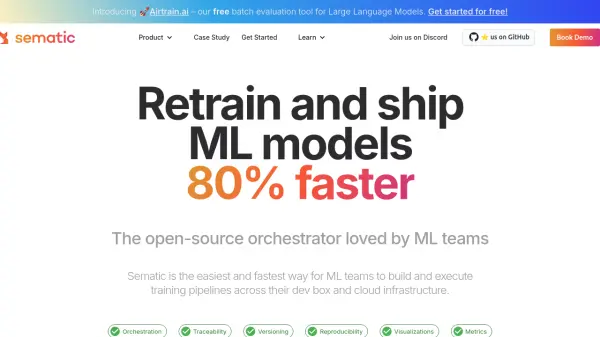What is Sematic?
Sematic provides an open-source solution for Machine Learning teams seeking to accelerate model retraining and deployment. It functions as a continuous machine learning platform, enabling the creation and execution of end-to-end Python pipelines. These pipelines can run seamlessly on a developer's local machine or scale up to a cloud cluster, facilitating faster iteration cycles.
The platform emphasizes a Python-first approach, allowing users to define pipeline aspects, including complex DAGs with dynamic elements like looping and branching, using Python functions instead of complex configuration files. Sematic automatically tracks and versions inputs, outputs, code, and dependencies for every step, ensuring reproducibility. It offers visualizations for various artifacts like dataframes, models, metrics, and plots directly within its dashboard, enhancing traceability and debuggability.
Features
- Python-first Declarative Orchestration: Define pipelines using Python functions, supporting complex DAGs.
- End-to-end Pipeline Execution: Run pipelines locally or scale seamlessly to Kubernetes clusters.
- Comprehensive Tracking & Versioning: Automatically track and version inputs, outputs, code, and dependencies.
- Artifact Visualization: Visualize dataframes, models, metrics, plots, and configurations in the dashboard.
- Reproducibility: Rerun pipelines from scratch or any point, with caching capabilities.
- Runtime Environment Packaging: Automatically packages local code and dependencies for cluster execution.
- Integration Support: Pluggable architecture integrates with various ML libraries, cloud tools, and observability services.
Use Cases
- Automating ML model retraining workflows.
- Building and managing complex ML pipelines.
- Accelerating the development cycle from local testing to cloud deployment.
- Ensuring reproducibility and traceability in ML experiments.
- Visualizing ML pipeline execution and artifacts.
- Scaling machine learning operations (MLOps).
Related Queries
Helpful for people in the following professions
Sematic Uptime Monitor
Average Uptime
99.86%
Average Response Time
196.73 ms
Featured Tools
Join Our Newsletter
Stay updated with the latest AI tools, news, and offers by subscribing to our weekly newsletter.






